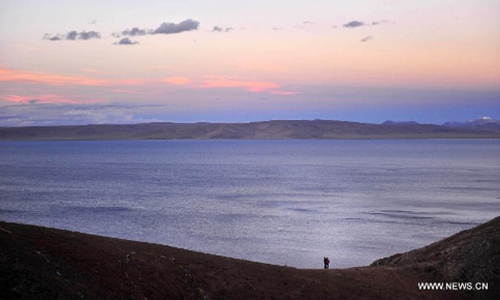100-meter core sediments of Tibet lake drilled for climate change study
Source: Global Times Published: 2020/7/22 11:08:40
Project aims to analyze climate and environmental changes of Qinghai-Tibet Plateau in past 150,000 years

Photo taken on Sept. 16, 2013 shows the sunset scenery of the lake Nam Co located at the boundary of Damxung and Baingoin counties, southwest China's Tibet Autonomous Region. Lake Nam Co, the highest saltwater lake of the world at 4,718 meters above the sea level, is regarded as a sacred lake in Tibetan Buddhism. (Xinhua/Liu Kun)
Chinese researchers have for the first time drilled hundred-meter core sediments of Lake Nam Co in Southwest China's Tibet autonomous region, which they believe will help with the analysis of its regional climate and environmental changes over the past 150,000 years.
Researchers from the Chinese Academy of Sciences and Qinghai-Tibet scientific expedition lake team successfully drilled 100.63-meter-long lake core sediments from the central lake area of Lake Nam Co on Tuesday, Xinhua News Agency reported.
This is the first time that China has ever obtained a lake core sediment more than 100 meters long in a high-altitude deep-water lake on the Tibetan Plateau, marking a breakthrough in deep-water lake sampling.
"Lake core" refers to lake sediments, substances that naturally sink to the bottom of the lake through the accumulation of gas or water. Some of the physical, chemical and biological substances will be used as indicators to reflect the depositional environment and climate from that time.
Wang Junbo, the head of the Nam Co Station for Multisphere Observation and Research affiliated with the Chinese Academy of Sciences, said the first hand materials provided a scientific basis for understanding the status of lakes on the Qinghai-Tibet Plateau and for coping with climate change.
Experts said the obtained lake core samples can help to analyze the climate and environmental changes that have taken place in the central Qinghai-Tibet Plateau over the past 150,000 years.
The Nam Co scientific drilling project on the Tibetan Plateau was part of the International Continental Scientific Drilling Program (ICDP) which saw the participation of 12 scientists from seven countries, including China, Germany, the UK and the US.
Scientists plan to drill a total of 2,250 meters of sediment at five points in Lake Nam Co to study its climate and environmental changes over the past 1 million years.
Studying Lake Nam Co will "provide good research materials for in-depth understanding of the evolution of the Earth in the northern hemisphere," experts from the Institute of Tibetan Plateau Research with the Chinese Academy of Sciences said.
ICDP is an international plan initiated in 1996 by Germany, the US and China, with a total of 21 member nations.
Newspaper headline: 100-meter core sediments of Tibet lake drilled for first time
RELATED ARTICLES:
Posted in: SOCIETY